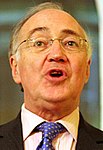UK local elections, 2005
|
|
|||||||||||||||||||||||||||||||||||||||||||||
|---|---|---|---|---|---|---|---|---|---|---|---|---|---|---|---|---|---|---|---|---|---|---|---|---|---|---|---|---|---|---|---|---|---|---|---|---|---|---|---|---|---|---|---|---|---|
|
|||||||||||||||||||||||||||||||||||||||||||||
|
All 34 non-metropolitan counties, 3 out of 46 unitary authorities, 1 sui generis authority, 4 directly elected mayors and all 26 Northern Irish districts |
|||||||||||||||||||||||||||||||||||||||||||||
|
|||||||||||||||||||||||||||||||||||||||||||||

Colours denote the winning party, as shown in the main table of results.
|
|||||||||||||||||||||||||||||||||||||||||||||
Elections for local government were held in the England and Northern Ireland on 5 May 2005 along with the 2005 general election across the entire United Kingdom. In addition, the Isle of Wight held a local referendum on the issue of a directly elected mayor.
Despite losing the general election held on the same day, the Conservatives made strong gains at Labour's expense, providing some comfort to the party. Conservative leader Michael Howard resigned soon afterwards and was succeeded by David Cameron, who had a decent platform to build on in his challenge to lead the Conservatives to a general election victory; the party had increased its share of council seats and importantly its share of seats in parliament.
Source: BBC local election results for England
In 34 shire county county council, all seats were up for re-election.
‡ New electoral division boundaries
In two unitary authorities the whole council were up for election and one had a third of the council up for election.
‡ New ward boundaries
Four direct mayoral elections were held.
All seats were up for election in the 26 districts of Northern Ireland. The many parties and the use of the single transferable vote meant that most councils ended up in no overall control. The DUP gained majority control of three councils: Ards, Ballymena, and Castlereagh.
Source: ARK research and knowledge group
...
Wikipedia



